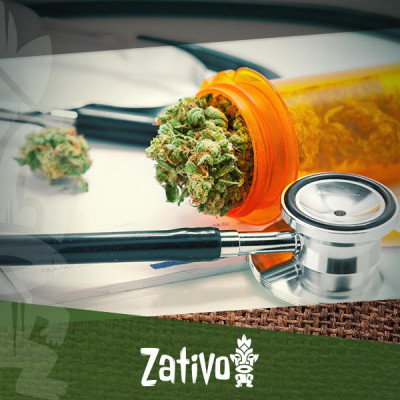Don't have an account?
Register NowYou have to add to cart at least 5 bottles or any program to make checkout.
- BlogUnderstanding Medical Marijuana
Understanding Medical Marijuana
Published: May 28th, 2020
Categories:
Medical Cannabis
For decades, cannabis was stigmatised, forcibly excluded from the domains of healing and medicine. However, in recent years, medical marijuana has taken the world by storm as more nations, doctors, and patients begin to recognise its vast potential.
First, to clarify: “marijuana” and “cannabis” are interchangeable terms, both of which refer to the Cannabis sativa L. plant, and the dried buds thereof. The buds are typically used in treatment, and may or may not be “psychotropic”—that is, able to alter one’s mental state. “Weed,” “pot”, and “ganja” are other more colloquial terms for the same thing.
If you’re considering using cannabis for your condition, it’s first important to understand what medical marijuana is, the different varieties, and how it works. Welcome to our 101 guide, where we’ll cover all of this, and end with some strain recommendations for common conditions.
WHAT IS MEDICAL MARIJUANA?
Medical marijuana is simply marijuana that’s used to treat a medical condition or symptom. Cannabis has a wide array of medicinal uses, but certain varieties are better suited to certain conditions than others. Many lay people don’t realise this, but there are myriad different varieties of cannabis, and different varieties can have vastly different medical applications.
One important distinction is the sativa-indica divide. This divide is technically based on plant morphology (sativas are taller than indicas, with thinner leaves), but these two variants also produce different medicinal effects. Sativas tend to be energising and uplifting, producing a euphoric “head” high. As such, sativas are generally recommended for daytime use. Indicas tend to be more relaxing, producing a soporific “body high”, often accompanied by hunger and lethargy. They’re usually recommended for nighttime use.
Cannabis strains can be further categorised according to their cannabinoid and terpene profiles. Cannabinoids and terpenes are molecules that produce the medicinal effects of cannabis, as well as its flavour. Common cannabinoids include THC, which produces the bulk of cannabis’ psychotropic effects and has specific medical applications, and CBD, which is non-psychotropic and has a wide range of beneficial effects. Finding the right cannabinoid and terpene profile is crucial for using marijuana medicinally.
HOW DO I START USING MEDICAL MARIJUANA?

The process for getting started with medical cannabis will vary according to region. In broad strokes, it involves acquiring a note from a medical doctor and using that note to acquire a license or card from the government. Once you’re certified, you can grow cannabis yourself, buy it from a dispensary, or acquire it from a doctor, depending on the laws in your jurisdiction.
HOW SHOULD I ACQUIRE CANNABIS?
In many places, you can acquire medical cannabis from your doctor or directly from the government. This will likely be a convenient choice as it will fit into your existing routine. However, this option is unlikely to offer you much strain variety. Depending on your condition, this could make the treatment less effective.
Another option is to visit a dispensary. Dispensaries currently exist across the United States, the UK, and many other countries in the Western world. Dispensaries generally offer a variety of options, a welcoming environment, and knowledgeable “budtenders” who can help you find the right strain to meet your needs. For those just starting out with medical marijuana, dispensaries are an excellent choice.
Those with more experience and expertise may get to the point where they want a very specific combination of strains or cannabinoids to treat their condition. Those in this category may want to consider growing their own cannabis. Check out our grow guide for advice on how to get started in this exciting world.
HOW SHOULD I TAKE MEDICAL MARIJUANA?

There are several different ways to take medical marijuana, and what works best for you will depend on your specific condition and needs.
A popular option is to use edibles. This is when cannabis is infused into a fat, which is then used as an ingredient in baking or cooking. Edibles have the benefits of being easy on the lungs, discreet, and easy to dose precisely (if you put a certain amount of cannabis into the recipe and it results in sixteen equal-sized brownies, you can calculate the exact amount of cannabis in each brownie). While smoked or vaporized cannabis lasts 3–6 hours, edibles can last up to 11 hours. Edibles also have a slightly different molecular profile than smoked cannabis, resulting in subtly different effects. You can either make edibles yourself, or buy them pre-made.
Another way to ingest cannabis is through vaping. This is when cannabis is heated such that the active compounds vaporize and can be inhaled. Unlike smoking, vaping is less harmful to the lungs, but may still be irritating to those with lung conditions. Vaping can be carried out using vape pens or dabbing rigs depending on the desired intensity.
Tinctures are another popular choice for medicinal users. Tinctures are alcohol-based cannabis infusions that can be consumed through sublingual application (under the tongue), allowing for immediate onset. The same goes for cannabis oils, which combine cannabis extract with a carrier oil.
The classic technique—smoking cannabis—is generally not recommended for medical use due to its harmful side effects on the lungs. Medical users with lung diseases are especially advised not to use this method.
FIND THE RIGHT MEDICAL CANNABIS FOR YOU

Medical cannabis holds promise in treating a wide range of conditions. More and more, the industry is focusing on customisation—that is, on developing the ideal treatment plan for each individual patient. If you make use of all resources available—this guide, other online resources, experts in your community—you should have no trouble developing a treatment plan that’s right for you.





